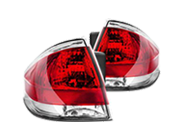
The Often Overlooked but Important Gas Door: A Guide to Types and Maintenance
When it comes to car maintenance and upgrades, one component that often gets overlooked is the gas door. This small yet crucial part of your vehicle serves multiple functions, from protecting your fuel tank to adding a touch of style to your car's exterior. In this blog post, we'll explore the world of gas doors, their types, and essential maintenance tips to keep them in optimal condition.
Types of Gas Doors:
Gas doors come in various styles and materials to suit different vehicle designs and personal preferences. Here are some common types:
Painted Gas Doors: These gas doors are usually color-matched to your car's exterior, providing a seamless and cohesive look. They blend in with the body of the vehicle, making them a popular choice for those who want a clean and discreet appearance.
Chrome Gas Doors: If you're looking to add a touch of shine and sophistication to your vehicle, chrome gas doors are an excellent choice. They offer a polished and reflective finish that complements other chrome accents on your car.
Billet Aluminum Gas Doors: Billet aluminum gas doors are known for their durability and distinctive look. These doors are often machined from solid aluminum, giving your vehicle a rugged and customized appearance.
Locking Gas Doors: Security-conscious drivers may prefer gas doors with integrated locks. These doors add an extra layer of protection to your fuel tank, deterring potential thieves from siphoning your fuel.
Custom Gas Doors: For those who want a truly unique look, custom gas doors are the way to go. These doors can be customized in terms of design, material, and finish, allowing you to create a gas door that matches your vehicle's personality perfectly.
Gas Door Maintenance Tips:
To ensure your gas door continues to serve its purpose effectively and look its best, consider these maintenance tips:
Regular Cleaning: Clean your gas door regularly to remove dirt, grime, and road debris. Use a mild detergent and a soft cloth to avoid scratching the surface.
Lubricate Hinges: If your gas door has hinges, apply a silicone-based lubricant to keep them operating smoothly. This prevents stiffness and ensures easy access to the fuel cap.
Inspect for Damage: Periodically check your gas door for signs of damage, such as dents, scratches, or rust. Promptly address any issues to prevent further deterioration.
Keep the Lock Functioning: If your gas door has a lock, test it occasionally to ensure it's working correctly. Lubricate the lock mechanism if it becomes stiff or difficult to use.
Conclusion:
While the gas door may not be the first thing that comes to mind when thinking about car upgrades and maintenance, it plays a crucial role in both protecting your fuel tank and enhancing your vehicle's appearance. With various types and materials available, you can choose a gas door that suits your style and needs. By following proper maintenance practices, you can keep your gas door looking and functioning its best, ensuring it continues to serve its essential purpose for your vehicle.




























